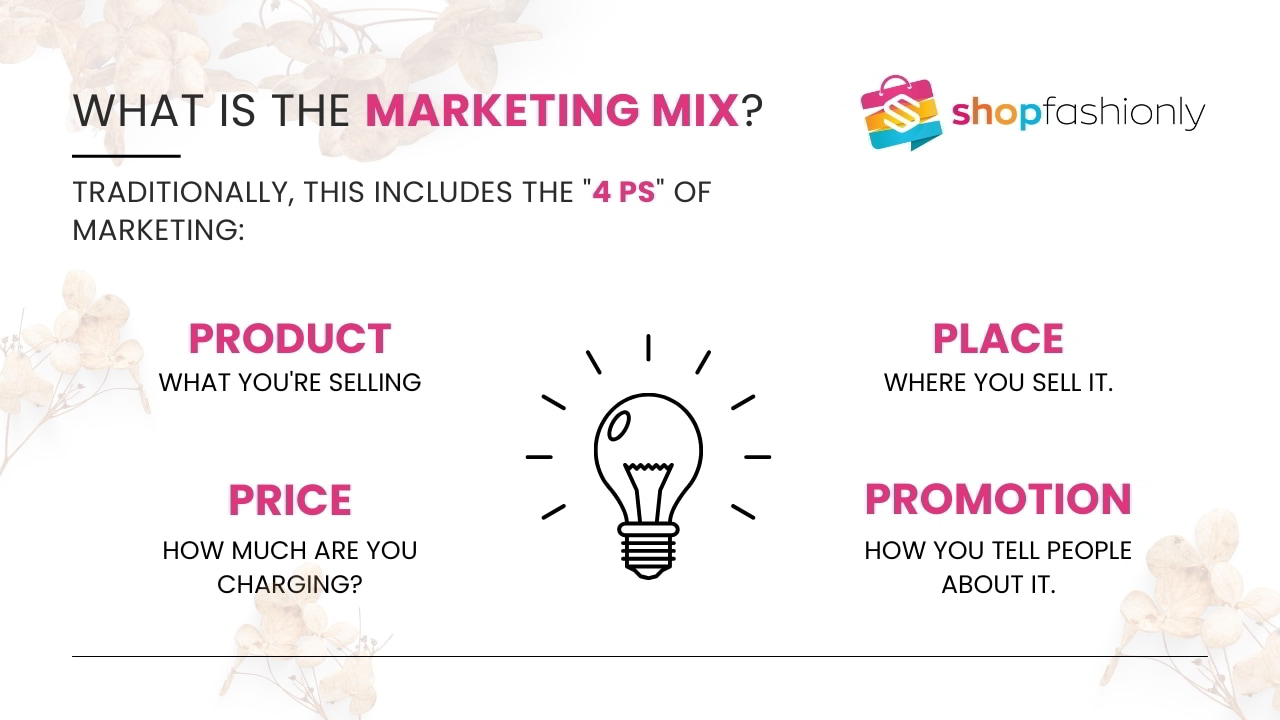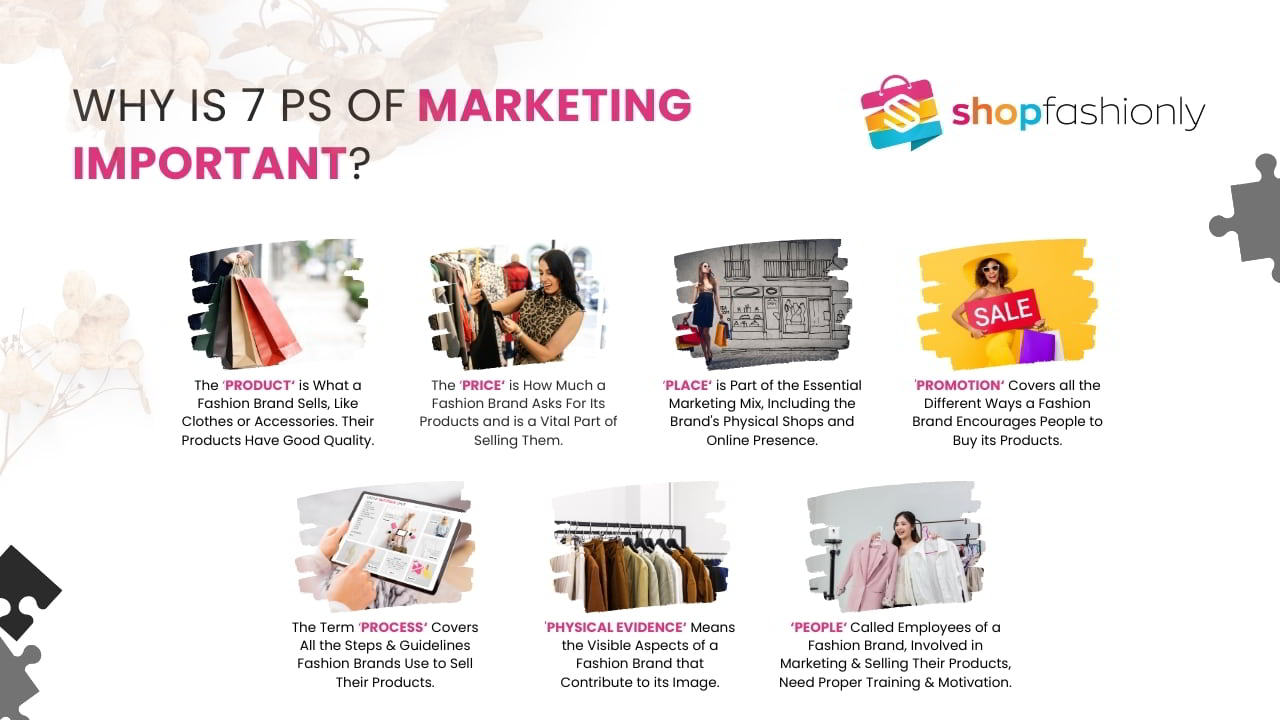Unlock the Secrets to a Perfect Fashion Marketing Mix: Dive into the 7 Ps – Product, Price, Place, Promotion, People, Process, and Physical Evidence
Greetings! Fashion and Marketing enthusiasts! I’m excited to guide you through the crucial concept of the FASHION MARKETING MIX today. It’s a vital component of strategic fashion industry planning, essential for creating brands that truly connect with their audience rather than simply existing without impact.

What is the Marketing Mix?

The marketing mix is a model that businesses use to create successful marketing strategies. It’s like a recipe for selling products or services. This recipe includes different ingredients that help a business reach its sales goals.
The marketing mix helps businesses think about the different ways they can sell their product or service. These ways can include things like how they price their product, where they sell it, how they promote it, and more.
Traditionally, this includes the “4 Ps” of marketing:
- Product: what you’re selling.
- Price: how much are you charging?
- Place: where you sell it.
- Promotion: how you tell people about it.
Some experts have expanded this list to include three additional Ps:
- Process: the steps customers go through to buy your product
- Physical Evidence: anything that shows your service exists, like a brochure.
- People: everyone involved in making and selling the product
What is the Marketing Mix in the Fashion Industry?

In fashion marketing, these same principles apply. However, fashion relies more on marketing because clothing and accessories are not just practical items—they often reflect personal style and can be seen as luxury items.
Fashion marketers focus on building an attractive brand image that encourages people to buy their products.
Why is 7 Ps of Marketing Important?
The 7 Ps of Marketing are crucial because they offer a clear plan for small business owners and marketing managers to stand out and connect with the ideal customer.
This is especially beneficial in the ever-changing landscape of digital marketing.
The 7 Ps framework helps with marketing strategies and makes day-to-day decisions easier, aiming to attract and successfully engage with the preferred audience.
These seven elements are designed to work together to help you promote your product or service effectively.
1. Product
The product is what a fashion brand sells, like clothes or accessories. It’s essential for brands to make sure their products have good quality, design, and are valuable.
When creating these items, they should think about who will buy them, the brand’s style, what customers need, and current fashion trends.
If you’re in the fashion industry, you have to ask yourself some key questions:
What’s the story behind your product?
Why should people choose it over another brand?
Lastly, consider what makes your item stand out from the crowd of look-alikes.
What’s that special something you offer that nobody else does? Keep it authentic, keep it you.
2. Price
The price is how much a fashion brand asks for its products and is a vital part of selling them.
Brands need to set prices that are fair and still make a profit, considering things like how much it costs to make the product, who else is selling similar items, who they are selling to, and how many people want to buy them.
Brands can use price in several ways to attract buyers. They can set high prices to make the items seem more desirable and high-quality.
They might also price items higher, so deals and package offer look better. Alternatively, a brand might set a lower price than others to stand out in a busy market or appeal to shoppers looking for good deals.
3. Place
‘Place’ is part of the essential marketing mix, including the brand’s physical shops and online presence.
The location of a physical store is critical—ideally, it should be in an area that’s desired and easy to access.
The way products are arranged and presented in the store also matters. A brand must be visible online on social media and search engines like Google.
Being easy to find online can be as valuable as a good physical location.
Having products in the right place is critical in fashion because customers tend to buy what’s easy for them to get. If a product is available where customers shop, they’re more likely to purchase it.
Brands place products near the checkout area or feature them prominently on the website’s payment page to attract your attention as you’re about to pay.
4. Promotion
‘Promotion’ is another part of the marketing mix. It covers all the different ways a fashion brand encourages people to buy its products.
This includes advertising, creating buzz through public relations, sales promotions, personal selling, and targeted emails or messages.
The key is choosing the right ways to reach your customers that fit your budget and goals.
Fashion brands combine these promotional methods for a smooth customer experience across all channels.
For instance, someone might see an item on sale in a store and then use their phone to compare prices or read reviews before buying it.
5. Process
The term ‘process’ covers all the steps and guidelines fashion brands use to sell their products.
It’s crucial for these steps to be clear and focused on serving the customer, ensuring a smooth and pleasant shopping experience.
Employees should be able to easily understand and implement these guidelines.
This includes how employees interact with shoppers, making it simple to find the right size, the fitting room experience, and the buying and returning procedures.
Some stores also consider the impact of their business on social issues and the environment.
6. Physical Evidence
‘Physical evidence’ means the visible aspects of a fashion brand that contribute to its image. These are things customers can see or touch when they engage with a brand.
It involves packaging choices, marketing materials in physical stores, and how customers view the brand online, including social media.
Fashion brands must ensure these elements align with their image and positively impress their customers.
They might do this by using recyclable packaging or showing their environmental efforts online.
7. People
Employees of a fashion brand, involved in marketing and selling their products, need proper training and motivation.
They should offer excellent customer service and positively represent the brand.
To ensure a strong brand image, it’s essential for all employees interacting with customers to understand the products well and explain their benefits.
Companies should invest in employee training and development to enhance skills, consider the company’s work culture and the brand’s image when hiring, recruit passionate employees, and focus on building customer relationships to foster brand loyalty.
Fashion businesses benefit greatly from using the 7 Ps of marketing. These include product, price, place, promotion, people, process, and physical evidence strategies.
Applying them can boost sales and give a better return on investment (ROI). They also help companies understand how well their marketing works and plan future budgets.
If you want to learn more about marketing in retail, our specialists can help. Contact us today!









